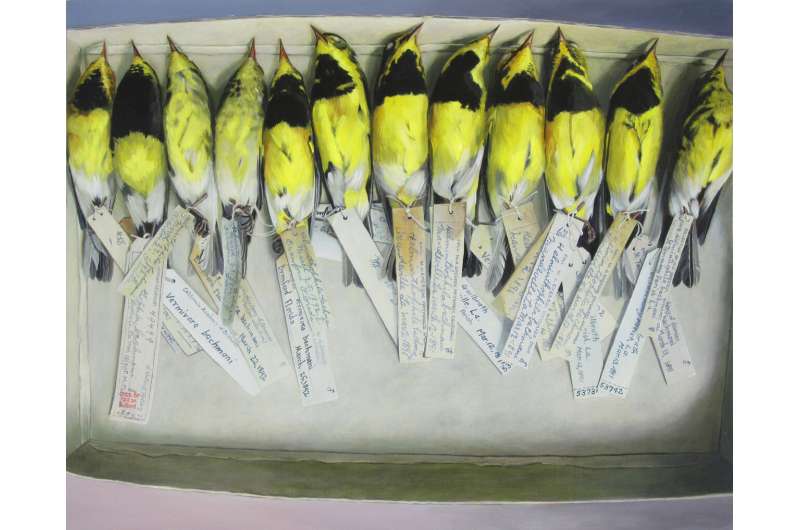This article has been reviewed according to Science X's editorial process and policies. Editors have highlighted the following attributes while ensuring the content's credibility:
fact-checked
peer-reviewed publication
trusted source
proofread
New study shows that the Bachman's warbler was a distinct species

The Bachman's warbler, a songbird that was last seen in North America nearly 40 years ago, was a distinct species and not a hybrid of its two living sister species, according a new study in which the full genomes of seven museum specimens of the bird were sequenced. Genome comparisons of Bachman's warbler with the golden-winged and blue-winged warblers also helped researchers identify a new candidate gene involved in feather pigmentation in the group. A paper describing the study, led by Penn State researchers, highlights the crucial role that museum collections can play in science and appears June 16, 2023 in the journal Current Biology.
"The Bachman's warbler is the only songbird known to have recently gone extinct in North America," said David Toews, assistant professor of biology in the Penn State Eberly College of Science and the leader of the research team. "It is one of three species in the genus Vermivora. Our lab studies the two living species of this genus, which are known to mate with each other producing hybrid offspring."
Golden-winged and blue-winged warblers produce a spectrum of hybrids, but two distinct types of hybrid offspring, each with a unique combination of the parent species' coloration, have been the focus of bird watchers and ornithologists. This is because these two hybrids were thought to be distinct species themselves, known as Brewster's warbler and Lawrence's warbler, until careful study of wild hybrids and, now, modern genetic analysis has confirmed their hybrid origins. The extinct Bachman's warbler resembles one of these hybrid offspring in coloration, so there was some question as to whether the Bachman's warbler was itself a distinct species or if it might also have been a hybrid.
The research team collected seven specimens of the Bachman's warbler from museum collections and extracted DNA from the birds' toepads. They then performed whole-genome sequencing to compare the Bachman's warbler genome to existing genomes for the two living species in the genus.
"It's never easy to get DNA for sequencing from museum specimens," said Andrew Wood, the first author of the paper, who was a research technologist in Toews' lab at the time of the research and is now a postdoctoral researcher at the University of Minnesota. "These birds were collected over a hundred years ago and were not preserved in any special way, but we were able to extract enough DNA to get genome sequences that are comparable to those from the living species."
The genomes of the golden-winged and blue-winged warblers are very similar to each other, except for a few regions that are involved in determining the coloration patterns of the bird's feathers. In comparison, the Bachman's warbler genome was very different, which indicated to the researchers that it was, in fact, a distinct species.
"We only have a small sample size for the Bachman's warbler genome, but one of the interesting findings we saw by comparing the seven specimens was that there were long 'runs of homozygosity,'" said Toews. "These are regions of the genome where the two copies of the genome—one inherited from each parent—are identical to each other and is an indication that the population may have been small and there was a lot of inbreeding. We see similar patterns in the living species, so understanding if this might have contributed to the extinction of Bachman's warbler could help us to better understand the health and conservation of the living population."
The researchers also compared the genomes of the three species to look for regions of the genome that may have evolved differently in each lineage. These differences can be indicators that a particular region of the genome evolved via natural selection for a particular trait or because of another evolutionary process. Having a third species' genome to compare allowed the researchers to identify a region that contained a new candidate gene involved in warbler pigmentation.
"We began this study because we were interested in learning about the history and biology of Bachman's warbler," said Woods. "But our results also highlighted how we can use extinct species to learn about their living relatives. We lose a lot of biological and evolutionary context through the process of extinction and being able to compare Bachman's warbler to the two living species allowed us to identify a gene that we might not have otherwise found. Context is crucial to understanding biology. Natural history collections allow us to place new observations into contexts that may have disappeared from the natural world. This fuels discovery, and makes museums powerful, and underappreciated, tools."
More information: Andrew W. Wood et al, Genomes of the extinct Bachman's warbler show high divergence and no evidence of admixture with other extant Vermivora warblers, Current Biology (2023). DOI: 10.1016/j.cub.2023.05.058
Journal information: Current Biology
Provided by Pennsylvania State University

















